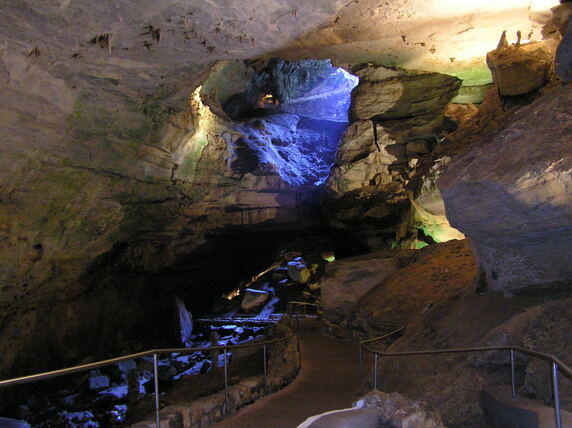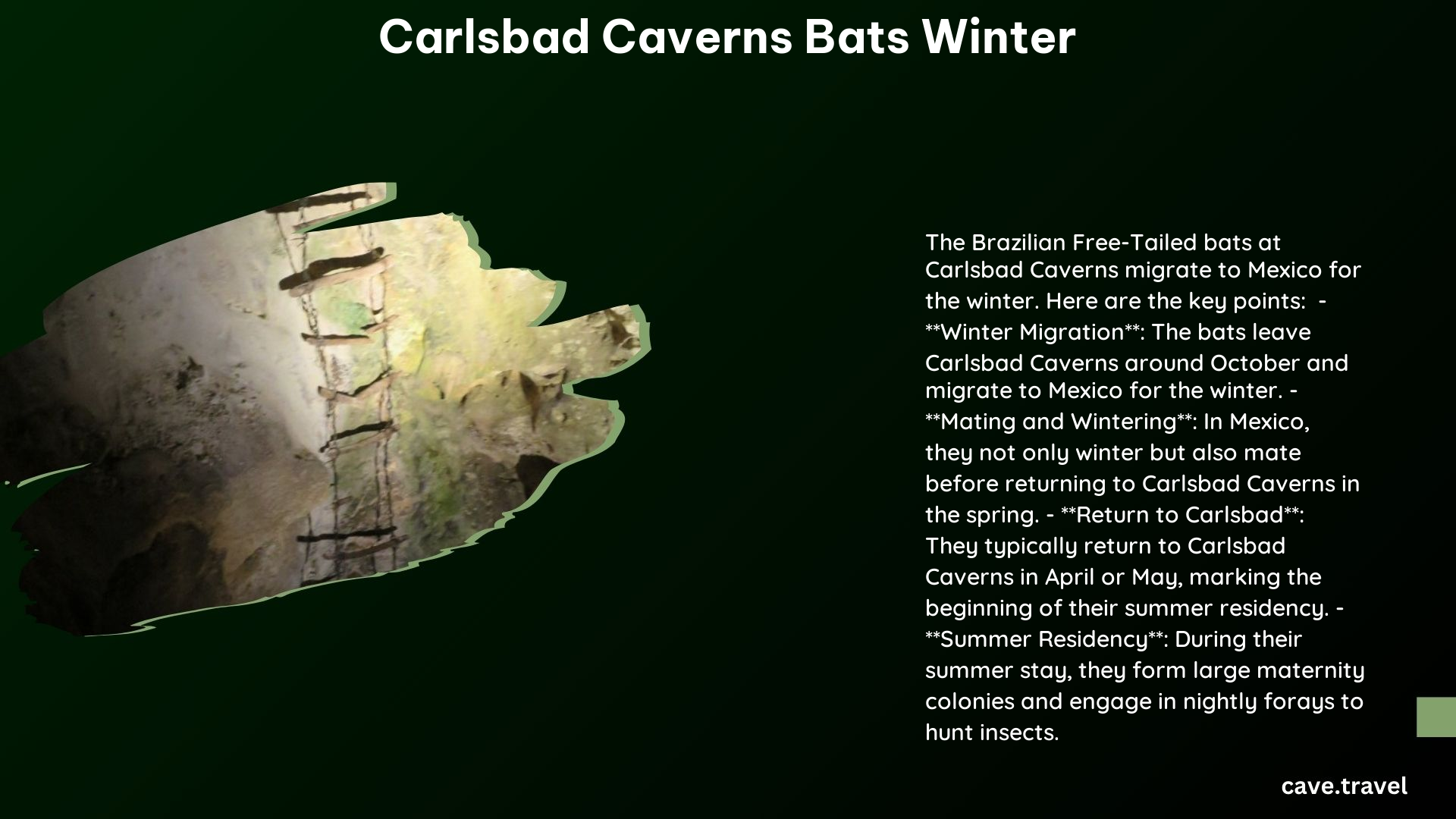Carlsbad Caverns, renowned for its massive bat population, experiences a significant change during winter. The Brazilian free-tailed bats, the primary species inhabiting the caverns, migrate to Mexico for the colder months. This seasonal exodus leaves the caverns largely devoid of bats from late October until March or April. Understanding this winter pattern is crucial for visitors and researchers alike, as it impacts both viewing opportunities and conservation efforts.
What Happens to Bats at Carlsbad Caverns in Winter?

The bats at Carlsbad Caverns, primarily Brazilian free-tailed bats (Tadarida brasiliensis), do not hibernate in the caverns during winter. Instead, they embark on a long-distance migration to southern Mexico. This migration pattern is a key aspect of their annual life cycle and has significant implications for the ecosystem and visitor experience at Carlsbad Caverns.
Where Do the Bats Go?
During their winter migration, the bats from Carlsbad Caverns travel to various states in Mexico, including:
- Nuevo León
- Tamaulipas
- Durango
- Sinaloa
Specific winter roosts have been identified, such as:
- Cueva de La Boca in Nuevo León
- Grutas de Quintero in Tamaulipas
- Cueva de La Isla Janitzio in Michoacán
These locations provide suitable conditions for the bats during the colder months, offering protection and food sources.
What Bat Species Are Present at Carlsbad Caverns?

While the Brazilian free-tailed bat is the primary species found at Carlsbad Caverns, other bat species are also present:
| Species | Scientific Name | Migration Behavior |
|---|---|---|
| Brazilian free-tailed bat | Tadarida brasiliensis | Migrates to Mexico |
| Myotis bats | Various Myotis species | Some may hibernate locally |
The Myotis bats are more susceptible to hibernation and thus more affected by White-Nose Syndrome, a fungal disease that has been devastating bat populations across North America.
How Does Winter Affect Bat Activity in the Caverns?
Winter has a profound impact on bat activity within Carlsbad Caverns:
- Minimal bat presence from late October to March/April
- Brazilian free-tailed bats are absent due to migration
- Some Myotis species may remain but in much smaller numbers
- Overall, the caverns are largely devoid of bats during winter months
This seasonal change significantly alters the ecosystem dynamics within the caverns and affects visitor experiences.
When Is the Best Time to View Bats at Carlsbad Caverns?
For optimal bat viewing at Carlsbad Caverns:
- Summer Months (Best)
- Large numbers of bats present
- Evening bat flights are spectacular
-
Millions of bats exit the cavern at sunset
-
Winter Months (Not Recommended)
- Brazilian free-tailed bats absent
- Minimal bat activity
- No guaranteed sightings
Visitors planning to see the famous bat flights should schedule their trips during the summer season for the best experience.
What Rules Should Visitors Follow to Protect Bats?
To ensure the protection of bats and their habitat, visitors must adhere to specific guidelines:
- Stay out of closed caves and areas
- Decontaminate caving and hiking gear, including footwear
- Do not handle bats
- Report any dead or sick bats to park rangers or state biologists
- Follow all park rules and ranger instructions
- Maintain a respectful distance from bat habitats
- Avoid using flash photography during bat flights
These rules help prevent the spread of White-Nose Syndrome and minimize disturbance to the bat population.
How Does White-Nose Syndrome Affect Carlsbad Caverns Bats?
White-Nose Syndrome (WNS) is a significant concern for bat populations, including those at Carlsbad Caverns:
- WNS primarily affects hibernating bats
- Brazilian free-tailed bats are less susceptible due to their migration behavior
- Myotis species are more vulnerable to WNS
- The disease has been detected in Carlsbad Caverns National Park
- Prevention measures are crucial to protect remaining bat populations
Visitors play a vital role in preventing the spread of WNS by following decontamination procedures and park guidelines.
What Research Is Being Conducted on Carlsbad Caverns Bats?
Ongoing research at Carlsbad Caverns focuses on various aspects of bat ecology:
- Migration patterns and timing
- Population dynamics
- Impact of climate change on bat behavior
- White-Nose Syndrome monitoring and prevention
- Ecosystem roles of bats in the caverns and surrounding areas
This research is crucial for conservation efforts and understanding the long-term health of bat populations in the region.
How Do Bats Contribute to the Carlsbad Caverns Ecosystem?
Bats play a vital role in the Carlsbad Caverns ecosystem:
- Insect control: Consume vast quantities of insects nightly
- Nutrient cycling: Guano deposits support unique cave ecosystems
- Pollination: Some species contribute to plant pollination outside the caverns
- Seed dispersal: Assist in spreading seeds of various plants
- Biodiversity indicators: Bat health reflects overall ecosystem health
Understanding these contributions highlights the importance of bat conservation efforts at Carlsbad Caverns.
What Are the Long-term Conservation Plans for Carlsbad Caverns Bats?
Long-term conservation plans for Carlsbad Caverns bats include:
- Continued monitoring of bat populations and migration patterns
- Implementation of strict WNS prevention protocols
- Habitat protection both in the caverns and at known wintering sites
- Public education programs on bat ecology and conservation
- Collaboration with international partners to protect migration routes
- Research into climate change impacts on bat behavior and habitat
These efforts aim to ensure the long-term survival of bat populations associated with Carlsbad Caverns.
Reference:
1. https://www.nps.gov/cave/learn/nature/wintering_bats.htm
2. https://www.tripadvisor.com/FAQ_Answers-g143018-d2264088-t4776136.html
3. https://www.nationalparkstraveler.org/2024/05/white-nose-syndrome-turns-carlsbad-cavern-national-park
